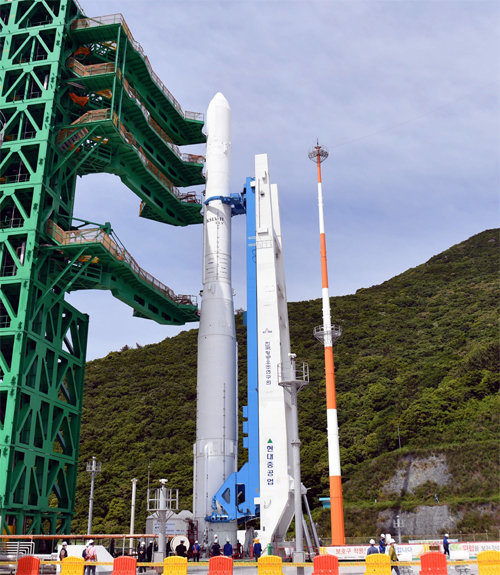South Korea takes one step closer to space development
South Korea takes one step closer to space development
Posted June. 02, 2021 07:29,
Updated June. 02, 2021 07:29

South Korea’s homegrown space launch vehicle Nuri, which is set to be launched in October, has been erected on its launch pad. Although it is a qualification model (QM) instead of a flight model (FM), this is the first time that a fully assembled model of Nuri rocket was connected to a launch pad in that both models are manufactured using the same shape and design structure.
The Ministry of Science and ICT and the Korea Aerospace Research Institute (KARI) said on Tuesday that they will carry out certification tests for the second launch pad, on which Nuri rocket will be launched, at the Naro Space Center in Goheung, South Jeolla Province. Once certification tests are completed successfully by July, Nuri rocket is expected to be launched into the space in October as scheduled.
The QM of Nuri rocket was erected at 90 degrees to the vertical structure called “umbilical tower.” The 48-meter structure supplies propellants and gases to the launch vehicle on the pad.
The three-stage Nuri rocket is a 47.2-meter-long and 200-ton space launch vehicle, which can carry a 1.5-ton satellite into low orbit at 600-800km altitude. The rocket uses four 75t liquid engines in stage 1, one 75t liquid engine in stage 2, and one 7-ton liquid engine in stage 3. South Korea has invested more than 1.95 trillion won to develop the country’s first homegrown space launch vehicle since 2010.
The second launch pad, on which a QM of the Nuri has been erected, is meaningful in that it was independently developed with home-grown technology from the initial concept to design and production. South Korea sought the assistance of Russia when producing the first launch pad for the Naro-1 in 2013.
The certification tests for the launch pad, which will run until next month, will look at whether the Nuri and the launch pad function properly before an actual launch. The same procedure as in actual launch will be carried out in seven steps, starting with erecting the Nuri on the launch pad, checking the propulsion supply system, charging and discharging propellants, and separating the fixing device that binds the vehicle to the launch pad.
“If the certification tests on a QM of the Nuri and the launch pad are completed successfully, following the success of the comprehensive combustion test of the first stage QM of the Nuri in March, the performance verification of the Nuri and the launch pad will be completed,” said Hwang Seong-hoon, head of the space technology department at the Ministry of Science and ICT.
shinjsh@donga.com







